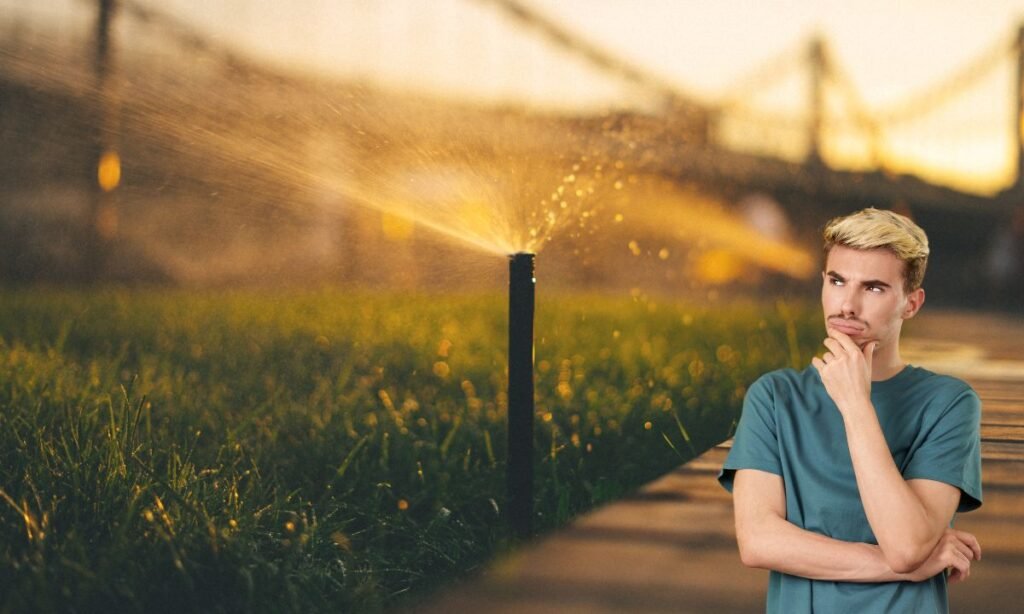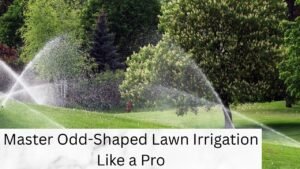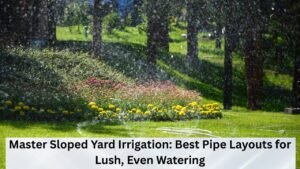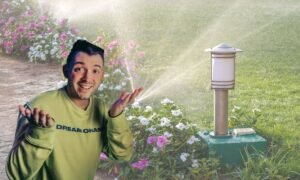
Maintaining a lush, green lawn on a one-acre property in Wichita requires careful planning, especially when it comes to installing sprinkler systems. Wichita’s hot summers and variable rainfall make effective irrigation essential.
This guide will walk you through determining the right number of sprinkler heads for your property, ensuring efficient water usage and a vibrant landscape.
Why Proper Sprinkler Head Placement Matters
The Youtube video below: Irrigation Design Tip – Sprinkler Head Layout by Ewing Outdoor Supply provides practical advice on positioning sprinkler heads for optimal coverage. It’s a useful visual guide for homeowners and DIYers wanting to design efficient, well-watered lawns.
Wichita’s climate, with its hot summers and occasional rainfall, demands a well-planned irrigation system. Proper sprinkler head placement ensures that every inch of your lawn gets the right amount of water, avoiding dry patches and water waste.
Here’s how to determine the right number of sprinkler heads for your one-acre property.
Factors Affecting the Number of Sprinkler Heads
Several factors influence the number of sprinkler heads you’ll need for a one-acre property. Understanding these factors will help you make informed decisions.
1. Sprinkler Type
The type of sprinkler head you choose impacts the coverage area and efficiency of your system:
- Rotors: These sprinklers cover large areas with a rotating stream of water. They are ideal for expansive lawns like those common in Wichita. For one acre, you might use fewer rotor heads because they can cover up to 2,000 square feet each.
- Spray Heads: These are suitable for smaller areas and provide a fixed spray pattern. They are often used in combination with rotors and might cover about 1,200 square feet each. You may need more spray heads for detailed coverage.
- Drip Systems: Best for garden beds or specific plants, drip systems deliver water directly to plant roots, reducing waste. They are particularly useful for Wichita’s clay and loam soils, where water absorption rates vary.
Tip: Choose rotors for large, open areas and spray heads for specific, smaller zones or flower beds.
2. Water Pressure
Water pressure significantly affects how well your sprinklers perform:
- High Pressure: Higher water pressure can enhance sprinkler coverage, potentially allowing each head to cover a larger area, up to 20% more. Wichita’s average water pressure is between 40 and 60 PSI, which is generally adequate for most sprinkler systems.
- Low Pressure: If your pressure is lower, you may need more heads or a booster pump to achieve even coverage across your property.
Actionable Advice: Test your water pressure and consult with a professional Sprinkler Service Specialist if it falls below the optimal range for your chosen sprinkler system.
3. Soil Type
The Youtube video below: Types of Soil by AgriLife Starr explains different soil types and their characteristics. It helps homeowners understand soil composition, which is essential for choosing the right irrigation methods and maintaining healthy lawns.
Wichita’s soil composition affects how water is absorbed:
- Clay Soil: Absorbs water slowly and may require fewer heads but with wider spacing. This is because clay retains moisture for longer periods.
- Loam Soil: Offers a balance between drainage and absorption, making it easier to manage with standard head spacing.
- Sandy Soil: Drains quickly, necessitating more frequent watering and closer head spacing to ensure adequate coverage.
Recommendation: Conduct a soil test to understand your soil type and adjust your sprinkler system accordingly.
4. Plant Needs
Different plants have varying water requirements:
- Grass: Typically needs more frequent watering than shrubs or trees. Ensure your system provides consistent coverage to support healthy grass growth.
- Shrubs and Trees: These may need less frequent but deeper watering. Adjust your sprinkler heads to target the root zones of these plants.
Tip: Use a combination of spray and drip systems to meet the diverse needs of different plants.
5. Lawn Size and Shape
The shape and size of your lawn affect sprinkler placement:
- Rectangular or Square Lawns: Easier to cover with a regular pattern of sprinkler heads.
- Irregular Lawns: May require additional heads or custom patterns to ensure even coverage.
- Obstacles: Trees, flower beds, and other features need to be factored in to avoid obstructed watering.
Calculating the Number of Sprinkler Heads
To determine how many sprinkler heads you need, follow these steps:
- Estimate Coverage Area: Each sprinkler head covers a specific area. For example:
- Rotors: Up to 2,000 square feet.
- Spray Heads: About 1,200 square feet.
- Basic Calculation:
- Lawn Area: 43,560 square feet (1 acre).
- Coverage Area per Head: If using spray heads covering 1,200 square feet each, you’ll need approximately 36 heads (43,560 / 1,200).
- Adjust for Factors: Account for water pressure, soil type, and plant needs to refine your estimate.
Example Calculation for a Rotor System:
- Coverage Area per Rotor: 2,000 square feet.
- Estimated Number of Rotors: 22 heads (43,560 / 2,000).
Sprinkler Head Spacing and Placement
Proper spacing ensures even coverage and minimizes water waste:
- Standard Spacing: Generally, space heads 50-75% of their coverage radius apart. For a head with a 15-foot radius, place them 7.5-11.25 feet apart.
- Placement Patterns: Common patterns include:
- Triangular: Effective for overlapping coverage.
- Square: Provides uniform coverage but may require more heads.
Common Challenges:
- Uneven Terrain: Adjust head heights or use adjustable heads to manage slopes.
- Obstacles: Position heads to avoid trees and structures that might block water flow.
Irrigation System Design Considerations
A well-designed system includes:
- Controllers: Regulate watering schedules and zones.
- Valves: Control the flow of water.
- Pipes: Distribute water efficiently across your property.
Design Tips:
- Zone Division: Group plants with similar water needs into the same zone.
- Pipe Layout: Plan efficient routes to reduce water loss.
- Backflow Prevention: Ensure your system prevents contamination of your water supply.
Consider Professional Help: Complex designs may benefit from expert installation.
Cost Considerations
Understanding costs helps you plan your budget:
- Materials: Costs vary by type and quality. Expect to spend between $1,500 and $6,000 for materials.
- Labor: Professional installation costs range from $500 to $2,000.
- Permits: Check local regulations for any required permits.
DIY vs. Professional Installation:
- DIY: Save on labor but requires significant effort.
- Professional: Ensures efficient setup and long-term savings.
Explore Financing Options: Look for financing or payment plans if needed.
Water Conservation and Maintenance
Effective maintenance and conservation practices save water and money:
- Water Conservation: Use smart controllers to adjust watering based on weather conditions, potentially saving up to 30% on your water bill.
- Maintenance Checklist:
- Monthly: Inspect and clean sprinkler heads.
- Seasonal: Check for leaks, and adjust settings for seasonal changes.
- Winterization: Prepare your system for colder weather to prevent damage.
Smart Controllers: Consider investing in a smart controller for automated adjustments and savings.
Local Tips: Adapt your system to Wichita’s climate and water restrictions.
Conclusion
Determining the right number of sprinkler heads for your one-acre property in Wichita involves understanding various factors such as sprinkler type, water pressure, soil composition, and plant needs. By following these guidelines and using accurate calculations, you can design an efficient irrigation system that keeps your lawn lush and green throughout the year.
For a vibrant, well-watered lawn, ensure your system is thoughtfully designed and regularly maintained. With the right approach, you’ll achieve a beautiful landscape that thrives in Wichita’s unique climate.





